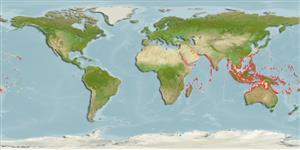>
Atheriniformes (Silversides) >
Atherinidae (Silversides) > Atherinomorinae
Etymology: Atherinomorus: Greek, atherina, the Greek name for the eperlane + Greek, moros = silly, stupid (Ref. 45335).
More on author: Forster.
Environment: milieu / climate zone / пределы глубины / distribution range
экология
морской; пресноводный; солоноватоводный ассоциированный с рифами; пределы глубины 1 - 39 m (Ref. 11897). Subtropical; 32°N - 23°S, 32°E - 154°W
Indo-Pacific: from East Africa to Tonga, north to southern Japan, and south to northern
Australia; except Andaman Sea. Replaced by Atherinomorus insularum in the Hawaiian Islands (Ref. 37816).
Size / Вес / Возраст
половая зрелость: Lm ? range ? - ? cm
Max length : 25.0 cm TL самец/пол неопределен; (Ref. 48635)
колючие лучи спинного плавника (общее число) : 5 - 8; членистые (мягкие) лучи спинного плавника (общее число) : 9 - 10; колючие лучи анального плавника: 1; членистые (мягкие) лучи анального плавника: 12 - 17; позвонки: 43 - 44. This species is distinguished by the following characters: lateral process of premaxilla very low and wide; upper margin of the dentary almost flat distally, no distinct tubercle at the posterior end; posterior tip of the upper jaw reaching to or beyond a vertical through anterior margin of the pupil, sometimes reaching to the center of pupil; small teeth on endopterygoids, not forming obvious ridges; the anus is near or usually behind the posterior tip of the pelvic fin; lower gill rakers 18-24; midlateral scale count 40-44; lower margin of midlateral band reaching below ventral end of the midlateral (third) scale row and reaching to almost the center of the fourth scale row at level of the anal fin origin (Ref. 58474).
Body shape (shape guide): elongated; Cross section: oval.
Common in large schools along sandy shorelines and reef margins. Reported to be mainly a nocturnal species which usually forms schools (from several hundred to more than 100 m long and 20 m wide) (Ref. 9760). Feeds mostly at night when the school disperse. Feeds on a variety of planktonic crustaceans. Preyed upon by sharks, tunas, long toms, and amberjacks which swim alongside the school. Among its other predators are crested terns, gannets, sea-gulls and herons. Slow moving and not well regarded as bait. Extremely important as forage fish for larger species (Ref. 3302). Sold fresh, or salted and dried (Ref. 12484). Minimum depth reported taken from Ref. 57178.
Life cycle and mating behavior
половая зрелость | размножение | нерест | икра | Fecundity | личинки
Kimura, S., D. Golani, Y. Iwatsuki, M. Tabuchi and T. Yoshino, 2007. Redescriptions of the Indo-Pacific atherinid fishes Atherinomorus forskalii, Atherinomorus lacunosus, and Atherinomorus pinguis. Ichthyol. Res. 54(2):145-159. (Ref. 58474)
Статус Красного Списка МСОП (Ref. 130435: Version 2025-1)
Угроза для людей
Harmless
Использование человеком
рыболовство: коммерческий; наживка: usually
дополнительная информация
инструменты
Специальные отчеты
Скачать в формате XML
ресурсы в Интернет
Estimates based on models
Preferred temperature (ссылка
123201): 24.9 - 29.1, mean 28 °C (based on 1080 cells).
Phylogenetic diversity index (ссылка
82804): PD
50 = 0.5020 [Uniqueness, from 0.5 = low to 2.0 = high].
Bayesian length-weight: a=0.00708 (0.00387 - 0.01296), b=3.17 (3.01 - 3.33), in cm total length, based on LWR estimates for this species & (Sub)family-body (Ref.
93245).
Trophic level (ссылка
69278): 3.3 ±0.2 se; based on diet studies.
устойчивость к внешним воздействиям (ссылка
120179): средний (среднего размера), минимальное время удвоения популяции 1.4-4.4 года (Preliminary K or Fecundity.).
Fishing Vulnerability (Ref.
59153): Low vulnerability (15 of 100).
🛈
Nutrients (Ref.
124155): Calcium = 39 [17, 99] mg/100g; Iron = 0.558 [0.287, 0.992] mg/100g; Protein = 20.4 [18.0, 22.7] %; Omega3 = 0.21 [0.09, 0.51] g/100g; Selenium = 13.4 [5.8, 30.5] μg/100g; VitaminA = 70.5 [22.0, 236.9] μg/100g; Zinc = 1.18 [0.73, 1.83] mg/100g (wet weight);
